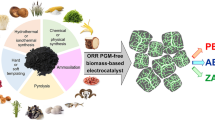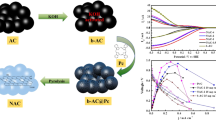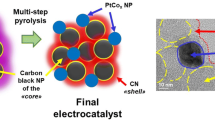Abstract
A new family of PtFe catalysts supported on hierarchical porous carbon (HPC), with different porous sizes, was developed and tested as cathodes in oxygen reduction reaction in acetate-fed microbial fuel cells. The results obtained were compared with carbon black (CB), CB-PtFe supported catalysts. HPC400 was characterized by cyclic voltammetry, showing a good electrolyte accessibility in contrast to CB. The XPS analysis of HPC supports show a low content of oxygenated species on carbon surfaces. The morphological and structural properties of catalysts were characterized by SEM-EDX and XRD. The electrochemical performance was examined by cyclic voltammetry (CV) and linear sweep voltammetry (LSV). The CO stripping voltammetry was applied for the determination of the surface area of PtFe catalysts; these experiments were carried out in a three-electrode system. In oxygen reduction experiments by LSV, HPC400-PtFe and CB-PtFe show good current densities of − 10.3 mA cm−2 and − 9.09 mA cm−2, respectively. HPC300-PtFe presents the poorest performance (− 2.3 mA cm−2). The HPC500-PtFe is the catalyst with the major current density (− 26.19 mA cm−2). A similar behavior is obtained in microbial fuel cell (MFC) catalyst performances; the MFCs were evaluated during 16 days until biofilm formation and stabilization. An increment of the power density was observed with the number of days. The power density obtained for HPC500-PtFe was 3218.89 mW m−2, showing better performances compared with CB-PtFe (743.18 mW m−2), HPC400-PtFe (578.82 mW m−2), and HPC300-PtFe (266.82 mW m−2). Hierarchical porous structure in combination with large-sized macropores enhanced the catalytic activity of PtFe toward oxygen reduction reaction in microbial fuel cells.








Similar content being viewed by others
References
Kharecha PA, Hansen JE (2013) Prevented mortality and greenhouse gas emissions from historical and projected nuclear power. Environ Sci Technol 47(9):4889–4895
Howarth RW (2014) A bridge to nowhere: methane emissions and the greenhouse gas footprint of natural gas. Energy Sci Eng 2(2):47–60
Jakob M, Hilaire J (2015) Climate science: unburnable fossil-fuel reserves. Nature 517(7533):150–151
Franks AE, Malvankar N, Nevin KP (2010) Bacterial biofilms: the powerhouse of a microbial fuel cell. Biofuels 1(4):589–604
Scott K, Yu EH (2015) Microbial electrochemical and fuel cells: fundamentals and applications. Woodhead Publishing
Rahimnejad M, Ghoreyshi AA, Najafpour GD, Younesi H, Shakeri M (2012) A novel microbial fuel cell stack for continuous production of clean energy. Int J Hydrog Energy 37(7):5992–6000
ElMekawy A, Hegab HM, Dominguez-Benetton X, Pant D (2013) Internal resistance of microfluidic microbial fuel cell: challenges and potential opportunities. Bioresour Technol 142:672–682
Watson VJ, Nieto Delgado C, Logan BE (2013) Influence of chemical and physical properties of activated carbon powders on oxygen reduction and microbial fuel cell performance. Environ Sci Technol 47(12):6704–6710
Ghasemi M, Daud WRW, Hassan SHA, Oh S-E, Ismail M, Rahimnejad M, Jahim JM (2013) Nano-structured carbon as electrode material in microbial fuel cells: a comprehensive review. J Alloys Compd 580:245–255
Rismani-Yazdi H, Carver SM, Christy AD, Tuovinen OH (2008) Cathodic limitations in microbial fuel cells: an overview. J Power Sources 180(2):683–694
Cheng S, Liu H, Logan BE (2006) Power densities using different cathode catalysts (Pt and CoTMPP) and polymer binders (Nafion and PTFE) in single chamber microbial fuel cells. Environ Sci Technol 40(1):364–369
Wang J, Li B, Yersak T, Yang D, Xiao Q, Zhang J, Zhang C (2016) Recent advances in Pt-based octahedral nanocrystals as high performance fuel cell catalysts. J Mater Chem A 4(30):11559–11581
Zhang J-N, You S-J, Yuan Y-X, Zhao Q-L, Zhang G-D (2011) Efficient electrocatalysis of cathodic oxygen reduction with Pt–Fe alloy catalyst in microbial fuel cell. Electrochem Commun 13(9):903–905
Li X, Faghri A (2013) Review and advances of direct methanol fuel cells (DMFCs) part I: design, fabrication, and testing with high concentration methanol solutions. J Power Sources 226:223–240
Balgis R, Sago S, Anilkumar GM, Ogi T, Okuyama K (2013) Self-organized macroporous carbon structure derived from phenolic resin via spray pyrolysis for high-performance electrocatalyst. ACS Appl Mater Interfaces 5(22):11944–11950
Banerjee R, Hinebaugh J, Liu H, Yip R, Ge N, Bazylak A (2016) Heterogeneous porosity distributions of polymer electrolyte membrane fuel cell gas diffusion layer materials with rib-channel compression. Int J Hydrog Energy 41(33):14885–14896
Larouche N, Chenitz R, Lefèvre M, Proietti E, Dodelet J-P (2014) Activity and stability in proton exchange membrane fuel cells of iron-based cathode catalysts synthesized with addition of carbon fibers. Electrochim Acta 115:170–182
Shen Y, Li F, Li S, Liu D, Fan L, Zhang Y (2012) Electrochemically enhanced photocatalytic degradation of organic pollutant on β-PbO2-TNT/Ti/TNT bifunctional electrode. Int J Electrochem Sci 7:8702–8712
Xu JB, Zhao TS (2013) Mesoporous carbon with uniquely combined electrochemical and mass transport characteristics for polymer electrolyte membrane fuel cells. RSC Adv 3(1):16–24
Rodriguez RC, Moncada AB, Acevedo DF, Planes GA, Miras MC, Barbero CA (2013) Electroanalysis using modified hierarchical nanoporous carbon materials. Faraday Discuss 164:147–173
Baena-Moncada AM, Coneo-Rodríguez R, Calderón JC, Flórez-Montaño J, Barbero CA, Planes GA, Rodríguez JL, Pastor E (2014) Macroporous carbon as support for PtRu catalysts. Int J Hydrog Energy 39(8):3964–3969. https://doi.org/10.1016/j.ijhydene.2013.06.085
Kruk M, Jaroniec M, Sayari A (1997) Application of large pore MCM-41 molecular sieves to improve pore size analysis using nitrogen adsorption measurements. Langmuir 13(23):6267–6273
Barrett EP, Joyner LG, Halenda PP (1951) The determination of pore volume and area distributions in porous substances. I. Computations from nitrogen isotherms. J Am Chem Soc 73(1):373–380
Ren Z, Ward TE, Regan JM (2007) Electricity production from cellulose in a microbial fuel cell using a defined binary culture. Environ Sci Technol 41(13):4781–4786
Baena-Moncada AM, Planes GA, Moreno MS, Barbero CA (2013) A novel method to produce a hierarchical porous carbon as a conductive support of PtRu particles. Effect on CO and methanol electrooxidation. J Power Sources 221:42–48. https://doi.org/10.1016/j.jpowsour.2012.07.138
Tourabi M, Nohair K, Traisnel M, Jama C, Bentiss F (2013) Electrochemical and XPS studies of the corrosion inhibition of carbon steel in hydrochloric acid pickling solutions by 3, 5-bis (2-thienylmethyl)-4-amino-1, 2, 4-triazole. Corros Sci 75:123–133
Lufrano F, Staiti P (2010) Mesoporous carbon materials as electrodes for electrochemical supercapacitors. Int J Electrochem Sci 5:903–916
Wagner CD (1979) Handbook of X-ray photoelectron spectroscopy: a reference book of standard data for use in X-ray photoelectron spectroscopy. Perkin-Elmer
Barbero C, Silber JJ, Sereno L (1988) Studies of surface-modified glassy carbon electrodes obtained by electrochemical treatment: its effect on Ru (bpy) 2+ 3 adsorption and the electron transfer rates of the Fe2+/Fe3+ couple. J Electroanal Chem Interfacial Electrochem 248(2):321–340
Kötz R, Carlen M (2000) Principles and applications of electrochemical capacitors. Electrochim Acta 45(15-16):2483–2498
Pyun SI, Kim CH, Kim SW, Kim JH (2002) Effect of pore size distribution of activated carbon electrodes on electric double-layer capacitor performance. J New Mater Electrochem Syst 5:289–296
Conway BE (2013) Electrochemical supercapacitors: scientific fundamentals and technological applications. Springer Science & Business Media
Andreas HA, Conway BE (2006) Examination of the double-layer capacitance of an high specific-area C-cloth electrode as titrated from acidic to alkaline pHs. Electrochim Acta 51(28):6510–6520
Zhang Z, Li M, Wu Z, Li W (2010) Ultra-thin PtFe-nanowires as durable electrocatalysts for fuel cells. Nanotechnology 22:15602
Li W, Zhou W, Li H, Zhou Z, Zhou B, Sun G, Xin Q (2004) Nano-stuctured Pt–Fe/C as cathode catalyst in direct methanol fuel cell. Electrochim Acta 49(7):1045–1055
Koo B, Lee S-M, Oh S-E, Kim EJ, Hwang Y, Seo D, Kim JY, Kahng YH, Lee YW, Chung SY, Kim SJ, Park JH, Jung SP (2019) Addition of reduced graphene oxide to an activated-carbon cathode increases electrical power generation of a microbial fuel cell by enhancing cathodic performance. Electrochim Acta 297:613–622
Jung S, Regan JM (2007) Comparison of anode bacterial communities and performance in microbial fuel cells with different electron donors. Appl Microbiol Biotechnol 77(2):393–402
Nam T, Son S, Kim E, Tran HVH, Koo B, Chai H, Kim J, Pandit S, Gurung A, Oh SE, Kim EJ, Choi Y, Jung SP (2018) Improved structures of stainless steel current collector increase power generation of microbial fuel cells by decreasing cathodic charge transfer impedance. Environ Eng Res 23(4):383–389
Funding
The authors received financial support granted from CONCYTEC/Innóvate Perú (Contract 367-PNICP-PIAP-2014).
Author information
Authors and Affiliations
Corresponding author
Additional information
Publisher’s note
Springer Nature remains neutral with regard to jurisdictional claims in published maps and institutional affiliations.
Electronic supplementary material
ESM 1
(DOCX 68.3 kb)
Rights and permissions
About this article
Cite this article
Baena-Moncada, A.M., Coneo-Rodríguez, R., La Rosa-Toro, A. et al. PtFe catalysts supported on hierarchical porous carbon toward oxygen reduction reaction in microbial fuel cells. J Solid State Electrochem 23, 2683–2693 (2019). https://doi.org/10.1007/s10008-019-04367-6
Received:
Revised:
Accepted:
Published:
Issue Date:
DOI: https://doi.org/10.1007/s10008-019-04367-6




